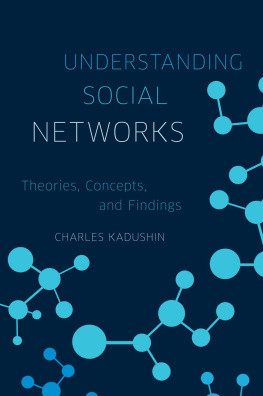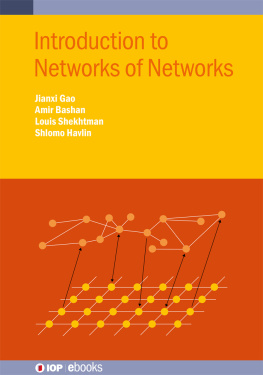Understanding Social Networks
THEORIES, CONCEPTS, AND FINDINGS
Charles Kadushin
UNDERSTANDING SOCIAL NETWORKS
Understanding Social Networks
THEORIES, CONCEPTS, AND FINDINGS
Charles Kadushin


Oxford University Press, Inc., publishes works that further
Oxford Universitys objective of excellence
in research, scholarship, and education.
Oxford New York
Auckland Cape Town Dar es Salaam Hong Kong Karachi
Kuala Lumpur Madrid Melbourne Mexico City Nairobi
New Delhi Shanghai Taipei Toronto
With offices in
Argentina Austria Brazil Chile Czech Republic France Greece
Guatemala Hungary Italy Japan Poland Portugal Singapore
South Korea Switzerland Thailand Turkey Ukraine Vietnam
Copyright 2012 by Oxford University Press
Published by Oxford University Press, Inc.
198 Madison Avenue, New York, New York 10016
www.oup.com
Oxford is a registered trademark of Oxford University Press.
All rights reserved. No part of this publication may be reproduced, stored in a retrieval system, or transmitted, in any form or by any means, electronic, mechanical, photocopying, recording, or otherwise, without the prior permission of Oxford University Press.
The author and publisher gratefully acknowledge permission to quote from or use previously published material under copyright. Elsevier Limited granted permission to use material from the authors published articles in Social Networks and for permission to quote from Borgatti, Stephen P., and Jos-Luis Molina. 2005. Toward ethical guidelines for network research in organizations. Social Networks 27 (2):107-117; Kalish, Yuval and Garry Robins. 2006. Psychological predispositions and network structure: The relationship between individual predispositions, structural holes and network closure. Social Networks 28:56-84.; and Valente, Thomas W. 1996. Social network thresholds in the diffusion of innovations. Social Networks 18:69-89. Taylor and Francis granted permission to quote from Granovetter, Mark, and Roland Soong. 1983. Threshold models of diffusion and collective behavior. Journal of Mathematical Sociology 9:165-179. Wolters Kluwer Health granted permission to quote from Rothenberg, Richard B., Claire Sterk, Kathleen E. Toomey, John J. Potterat, David Johnson, Mark Schrader, and Stefani Hatch. 1998. Using social network and ethnographic tools to evaluate syphilis transmission. Sexually Transmitted Diseases 25 (March):154-160.
Library of Congress Cataloging-in-Publication Data
Kadushin, Charles.
Understanding social networks: theories, concepts, and findings /Charles Kadushin.
p. cm.
Includes bibliographical references and index.
ISBN 978-0-19-537946-4 (cloth: alk. paper)ISBN 978-0-19-537947-1 (pbk.: alk. paper)
1. Social networks. I. Title.
HM741.K33 2011
302.3--dc22 2011014668
1 3 5 7 9 8 6 4 2
Printed in the United States of America
on acid-free paper
For Ghislaine Boulanger
Contents
Preface
WHEN I WAS a graduate student, before the term social networks came into general use, Paul F. Lazersfeld introduced his students to the idea of personal influence as a major factor in decision-making. Robert K. Merton had his seminar students read Georg Simmel line by line, among other matters explicating the ideas of triads and social circles. These teachings formed my introduction to social networks as problem-solving tools in understanding why people went to psychiatrists and how elites were organized. Hans Zetterberg insisted that social theory could and should be systematic. I am grateful to these mentors for getting me started on what became the study of social networks as key methodological and theoretical insights that could help to unpack social phenomena. I remain as much interested in the impact of social networks on social structure and cultural content as I am in the study of networks themselves. This book reflects that bias.
The Cohen Center for Modern Jewish Studies at Brandeis University, my colleagues there, and especially the director, Leonard Saxe, were extremely supportive while I was writing this book making time and intellectual space for the effort. Deborah Grant, managing editor of the Center, turned the manuscript into readable prose. Katherine Ulrich was a meticulous copy editor. I am grateful to the Brandeis Libraries for their wide subscriptions to electronic journals and data bases, making it easier to download an article than to go to my own library and find the hard copy version. Peter Prescott provided sage advice about publishing.
The social network field is so broad that it is almost impossible for a single individual to encompass it and get everything right and make things understandable to the non-mathematically inclined. To the extent that I managed at all is because a number of people have helped and encouraged me. Foremost is James Moody who reviewed an earlier version of the manuscript and gently pointed out omissions and commissions, and gave me feedback from a class to which he assigned that earlier version. Thomas Valente introduced me to Oxford University Press, provided me with an early draft of his very useful book Social networks and health: Models, methods, and applications, and was helpful in many other ways. Claude Fischer reviewed the chapters on concepts and several others as well. Others reviewed one or more chapters and are acknowledged in a footnote at the beginning of each chapter. They include: Richard Alba, H. Russell Bernard, the late S. D. Berkowitz, Andrew Braun, Michael Brimm, Cynthia F. Epstein, Linton Freeman, Bethamie Horowitz, Dani Maman, Amalya Oliver, Stuart Pizer, Robert Putnam, Gary Robins, Theodore Sasson, Leonard Saxe, Tom Snijders, Barry Wellman, and Douglas R. White. Remaining errors and infelicities are of course my responsibility.
My wife, Ghislaine Boulanger, who knows well the pangs of authorship, supported me throughout.
Fishers Island, July, 2011.
UNDERSTANDING SOCIAL NETWORKS
1 Introduction
NETWORKING SEEMS TO be on everyone lips. No one simply goes to a party anymore. They go to network. For many people, the World Wide Web exists for the main purpose of making connections. Networking seems familiar yet mysterious, accessible yet arcane. Social networks, however, have been at the core of human society since we were hunters and gatherers. People were tied together through their relations with one another and their dependence on one another. Tribes, totems, and hierarchies may have come later. Kinship and family relations are social networks. Neighborhoods, villages, and cities are crisscrossed with networks of obligations and relationships. Beyond kinship relations, people in modern societies are dependent upon one another for such things as picking up the mail when one is away, help with fixing the lawn mower, or recommendations for good restaurants. Nonetheless, it is said that urban Americans are becoming more and more socially isolated. The metaphor of bowling alone, rather than in clubs, leagues, or with friends, describes this picture of isolation and disengagement (Putnam 2000). But rather than disappearing, neighborhood and village-based groups celebrated as the heart of nineteenth-century America have become transformed from social relations and networks based on place or kinship into communities oriented around geographically dispersed social networks. The telephone and automobile started this revolution and were, not surprisingly, popular in rural areas where there were great distances between households. We have been networkers for millennia.
Next page









